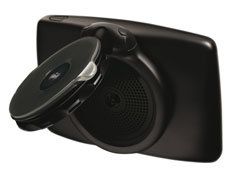Portable dashtop navigation devices have evolved through the years to be richly featured, affordable travel aids. As competition has seen the market whittle down to essentially three dominant brands, it has become easier for consumers to choose a good device. But we were reminded recently that a good device can be compromised by a bad mount.

In the course of our extensive testing program, we collect detailed data on the features and performance for the devices as engineers travel the greater New York City region and log hours in the lab. We also rate the mounts, looking for stability, portability, and adjustability. While this score counts for far less than the navigation performance of the device itself in the overall test score, it is a real factor for ownership. After a recent experience with a new TomTom unit, I want to encourage shoppers to look closely at our mount ratings.
In fact, let me take this a step further. There is one mount design offered by TomTom that seems extremely clever, though in reality, it proves to be quite frustrating: the ring-type mount. This is a simple concept, whereby a circular ring snaps onto the back of the device. A second ring with a suction cup attaches at a small hinge point. The result is an adjustable mount that folds flat, leaving the device to be travel friendly and even pocketable (depending on the pocket and screen size) with the mount still attached.
However, these mounts have a tendency to pop off the device and even the windshield, as I was reminded this past week with a relatively new TomTom. In the course of rotating through our latest test devices to gain real-world experience, I used a TomTom Start 45 TM. The mount simply would not stay attached to the windshield, popping off periodically while driving—a real distraction. That evening I had a passenger join me for a short road trip. Coincidentally, he is a TomTom owner, and he tried in vain to mount the device, but it repeatedly fell off the windshield or the mount popped off the device. Fortunately, he could hold it and guide me with his voice. Regardless of how good the device might be, I could not use it.
This is not just an anecdote. We've tested 28 different TomTom models recently, and the vast majority have a similar mount style. The worst offenders include the TomTom Ease, Start, XL, and XXL devices. The TomTom VIA and Go Live 1535 M mounts are similar, but they work better, because TomTom eliminated the ring that snaps onto the back of the GPS unit. The mount and GPS device are essentially one piece in this design and the attachment point is "ball-in-socket."
With a ball-in-socket design, a sphere on the mount snaps into an indentation on the device (think shoulder socket). Some such mounts use a magnet to secure the device to the mount, making it easy to remove, although adjustment can be tricky. These mounts are still compact, but seem to work better in our experience. This type can be found on the GO 2405, GO 2435, GO 2505, and GO 2535 in our ratings.
Ultimately, the solid adjustable arms from Garmin and Magellan have proven to be more dependable. Although less storage friendly, the compromise is worth it. We hope with its next-generation navigators that TomTom improves the mounts. Until then, do look closely at the ratings to ensure the devices you're considering will meet your expectations.
—Jeff Bartlett





